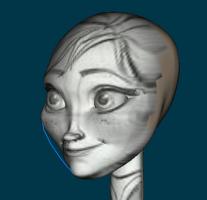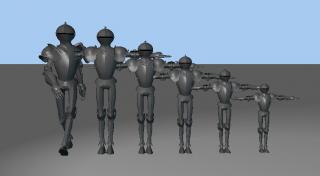-
Posts
21,649 -
Joined
-
Last visited
-
Days Won
119
Content Type
Profiles
Forums
Events
Everything posted by Rodney
-
Happy Birthday Bob! Thanks for making A:M what it is today. Out of all software offered of any kind or variety, it's still my favorite program. (Is Bob serious about this being only 50 years? I always pictured him as older)
-
Nice progress Steve. Looks like everything is coming together nicely. (This is a good time to say... Backup... Backup... Backup!)
-
Yes, I figured that. It's hard to gauge some things without seeing them in context and it's easy to assume the camera is the vantage point of another characters in a scene. Something that may have thrown me off as well is that while it's obvious he's looking up, his eyes are concealed when he roars so it isn't clear where his attention is at that moment, especially as his roar/snout appears to be toward camera. I know this will be more obvious when placed in context with the adjoining scenes but wanted to share what I am sensing/seeing. If the rest of the short is of the same quality... and knowing your standards it clearly will be... we are in for a real treat!
-
Very smooth animation Will. Impressive! Added: There is one thing that you could add that would really heighten the shot and that would be a fixing of the eyes toward (I assume) the hyenas which are (again I assume) at or near the camera. Tar's eyes roll upward and back but just before delivering his roar it'd be nice to see his eyes point toward his intended target. It'd signal a little projection that Tar is considering what he is doing before he actually does it. Not unlike the rolling of his eyes previously which seems to signal he is masking his intention. This shot happens quickly enough that you can get away without that anticipatory element but if you ever rerender the shot perhaps that might be something to consider. P.S. I enjoyed your write ups on your blog. More please!
-

Painting with Light? It Can't Be Done! Feb 2014
Rodney replied to robcat2075's topic in A:M Tutorials & Demos
Thanks Robert! You expertly demonstrate how we can extend A:M by creating our our utilities in A:M itself or via integration with other programs. Open Office (or a similar suite of tools) should be on everyone's computer whether for the purpose of indirectly manipulating elements in A:M or simply crafting a script, storyboard or framework for holding rendered images (i.e. through html). The fact that A:M's file format is accessible in this way is powerful and the results only limited by one's creative imagination. Thanks again for these videos! Edit: For those with the propensity to dream big dreams, I hope through videos such as these they can see how they can take the first step toward realizing those dreams. Creating a workable prototype (in Open Office or any program) can be a critical forerunner to programming a plugin and utility. If the process can be broken down and demonstrated to someone with a talent for programming then that process can then more easily be transferred, streamlined, automated and extended in other (programming) languages. -

Painting with Light? It Can't Be Done! Feb 2014
Rodney replied to robcat2075's topic in A:M Tutorials & Demos
I'm enjoying these Robert and looking forward to seeing how you automate rigging in Open Office. Which leads me to my next sentence... Your latest link points to Open Office rather than youtube (along with your link that corretly points to Open Office that is) Looking forward to seeing Episode 3! -
NICE! Boris and Natasha were always those strange characters that you knew you weren't suppose to like (because they were the villains!) but could not help and sympathize with (because they always lost) anyway. Kinda like that 'ol Wile E. Coyote thing (some kind of ultra captivating carefully crafted and maintained cartoon implementation of ze stockholmzyndrome).
-
That's awesome. It's great to see him getting some screen time. I'm guessing Floyd will also take advantage of the time to get the word out about his recent book: Animated Life: A Lifetime of Tips, Tricks and Stories from a Disney Legend
-

Sports Day (2014 Open Games) February
Rodney replied to Simon Edmondson's topic in Contests/Challenges
Nice reference! I was thinking of animating a pole vault but I thought the weight lift would be easier. As I'm not even working on the weight lift right now I'll have to pass on the pole vault. There is superb comedic opportunity in all of these... -
Awesome news Tom. We may have to mark your old computer as one to avoid purchasing! Glad to see you are back in operation.
-
Thanks to Gene's niece for the update. Someone get Gene a pencil and sketchbook (or two or three) and have him doodle ideas while he's away from his computer. No slacking there Gene! (Okay, maybe you can rest a little... but channel that creative energy into rehab and recovery! Okay? ) And speaking of Myron... he's sure been too quiet/absent as well! (We miss you Myron!)
-
Happy Birthday Mike!
-

Sports Day (2014 Open Games) February
Rodney replied to Simon Edmondson's topic in Contests/Challenges
I did not see that one coming. Your animation is getting very smooth these days! This is yet another reason why sharing project files is a good idea. I see from your file that you created that camera cut... in camera. Nice. I half way expected to see the Timeline quite messy but you are very organized. Nice job! -
Glad to hear you are back in action. As this will remain a mystery it may be worth noting that some folks experience problems with the Paste offset set in the Options Panel. If this is the case they can get back on track by either typing in different numbers or hitting Reset Settings on the Help menu. When in doubt and bad interface settings are suspected reverting to the factory installation settings can help.
-
Try selecting next to a Control Point and then use the comma key to select the rest of the spline (although selecting the whole spline is not required for lathing). Then Lathe. That should work.
-
You aren't too far off the mark. If you were to draw a straight line from cheek to chin you'd be pretty close.
-
Hang in there Gene. May God bless and keep you in his care and give you all the strength and patience you require.
-

Painting with Light? It Can't Be Done! Feb 2014
Rodney replied to robcat2075's topic in A:M Tutorials & Demos
Nicely done Robert! You've given me a few ideas with that approach. -
If the primitive wizard doesn't meet your requirements you can always roll your own spirals via the Duplicator Wizard (using the extrude setting rather than the copy setting of course). Here is a rough video (t is a variation on Robert Holmen's classic sea shell tutorial: Note that if you don't want any height in the spiral you simply leave the Y axis setting alone. In the video I create the spirals with height and then (in at least one instance) use Scale on the Y axis to decrease it. I use a simple spline line to create the spiral but other shapes work well too. Note that the real trick to success here is to have at least two spline objects on opposing sides of the Y axis. This way when the Duplicator wizard goes to work it will use the center between them as the point to revolve around. Disclaimer: You may want to download and view this in a video player that you can zoom in with because everything on screen is VERY tiny. creating_spirals_with_the_duplicator_wizard.mp4
-
While it might be good for a bug report (if you can consistently replicate the problem) it is possible Steffen could get the report and not be able to reproduce it if the problem is locally on your system (i.e. an out of date driver or somesuch). In a case like this it is appropriate to start a topic and explain the issue you are having and see if anyone can validate the problem. Once validated... it'll make a great report. My first thought is to examine the files in question but since I've been simulating the same project with the same images you are using... it doesn't seem to be related to the image itself. There has been reported a problem with OpenGL3 or... um... not sure. Set A:M to use OpenGL is what my memory recalls. At any rate, post a new topic and outline the issue. I'm confident that you'll be good to go in no time. There are a couple other things you can check. For instance, do you have the same problem with A:M in 32bit? Have you installed v18a? If not is that an option? I ask this because I don't know where you might be in your current production cycle. An upgrade in the middle of production is not something I would generally recommend to anyone unless it fixes a major problem or adds a new feature you cannot live without.
-
A few of those plugins work great for multiplying and scaling too: Edit: I should have made note that in some instances it may be adequate to just use the Duplicator plugin in the Modeling window but when using Newton Dynamics we often need the individual objects to have their own Bone. That's where plugins such as 'Brick' come into play because they duplicate the model with it's bone structure intact. Prior to that, one of the old methods was to reimport a model into the same model over and over and over and over... until you got the number you wanted. This often wasn't as bad as it seemed if you saved your model each time and reimported exponentially. But it is a lot easier to just click a word, set a number or two and... done.
-
No. Especially if it was Steffen. Steffen built *several* plugins just for the purpose of duplicating models. One is called 'bricks' but can be used to create other collections of objects. That plugins primary reason for existence of course was to make brick walls. If you Right Click you'll see several of the plugins/wizards depending on what window you are in. Simple Scatter is one. Multiple Models is yet another. Yes, Newton Physics creates all the movement and keyframes. When in doubt the keyframes can be forced (where none are) via Baking of Actions with a tolerance of 0 or 1. Other tolerances will set keyframes at appropriate intervals (i.e. a setting of 4 would produce a keyframe every four frames) If you haven't explored Steffen's other Newtonian projects they are well worth investigating: http://www.hash.com/NewtonPhysics/samples.html
-
I don't think you are doing anything wrong. Please note that I am simply deconstructing the files *as they are*. From what I can tell the two files are set up in tutorial fashion with the first just setting the stage for what will be added and then simulated. The second file is the 'desired' result. I won't be able to dig deeper until later tonight or tomorrow.










